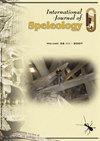不同的相关性属性是否表示相同的保护优先级?巴西东南部洞穴的个案研究
IF 1.3
4区 地球科学
Q3 GEOSCIENCES, MULTIDISCIPLINARY
引用次数: 3
摘要
在过去的十年里,科学界带来了争论的空白,这些空白减缓了全球生物多样性知识的进步。最近,这一讨论已经涉及到地下环境,由于其物种的遗存和脆弱的性质,这些差距更加引人注目。在这种情况下,我们测试了与这些缺口相关的生态指标,检查洞穴的生物相关性是否会根据与每个指标相关的生态属性而变化。这项研究是在巴西东南部的洞穴中进行的,该洞穴位于一个地理范围狭窄的地区,具有高度丰富的穴居物种。因此,我们利用脆弱性指数和洞穴保护重要值验证了洞穴无脊椎动物群落的脆弱性;(b)用特有指数说明穴居物种的分布和特有性;(c)考虑平均分类差异(∆+)、丰富度和均匀度的穴居物种系统发育多样性。我们观察到,根据每个被测试的属性(指数),洞穴的生物学相关性排序有很大的变化。我们讨论了这些指标及其属性如何间接地与:(a)地下群落系统发育多样性的保存和维持;(b)不同群体的空间限制,其限制越大,其脆弱性越大;(c)综合考虑这些不同的属性,保存具有高度生物关联性的洞穴。因此,我们建议使用不同的度量标准,以便考虑不同的生态属性,支持旨在保护高度变化地区洞穴的行动。最后,我们发现该地区最重要的生物洞穴(Gruta da Morena洞穴)没有得到保护。我们警告说,这个洞穴需要由该地区的保护单位紧急考虑。本文章由计算机程序翻译,如有差异,请以英文原文为准。
Do different relevance attributes indicate the same conservation priorities? A case study in caves of southeastern Brazil
In the last decade, the scientific community brought to the debate gaps that slow down the advance of knowledge regarding global biodiversity. More recently, this discussion has reached subterranean environments, where these gaps are even more dramatic due to the relict and vulnerable nature of their species. In this context, we tested ecological metrics related to some of these gaps, checking if the biological relevance of the caves would change depending on ecological attributes related to each metric. The study was carried out in caves from southeastern Brazil, located in a region presenting a high richness of troglobitic species restricted to a narrow geographical extent. Thus, we verified: (a) the cave invertebrate communities’ vulnerability with the Vulnerability Index and the Importance Value for Cave Conservation; (b) the distribution and endemicity of the troglobitic species with the Endemicity Index; (c) the phylogenetic diversity of the troglobitic species considering the average taxonomic distinction (∆+), their richness and evenness. We observed a considerable change in the ordering of the caves’ biological relevance according to each tested attribute (index). We discussed how each of these metrics and their attributes indirectly relate to: (a) the preservation and maintenance of the phylogenetic diversity of subterranean communities; (b) the spatial restrictions of different groups, where the greater their restrictions, the greater their vulnerability; (c) the preservation of caves with high biological relevance considering these different attributes together. Thus, we recommend the use of different metrics so that different ecological attributes can be considered, supporting actions that aim to preserve caves in highly altered regions. Finally, we find that the most biologically important cave in the region is not protected (Gruta da Morena cave). We warn that this cave needs to be contemplated by a conservation unit in the region urgently.
求助全文
通过发布文献求助,成功后即可免费获取论文全文。
去求助
来源期刊

International Journal of Speleology
地学-地球科学综合
CiteScore
3.10
自引率
23.10%
发文量
12
审稿时长
>12 weeks
期刊介绍:
The International Journal of Speleology has the aim to get cave and karst science known to an increasing number of scientists and scholars. The journal therefore offers the opportunity to all scientists working in and on karst to publish their original research articles or their review papers in an open access, high quality peer reviewed scientific journal at no cost. The journal offers the authors online first, open access, a free PDF of their article, and a wide range of abstracting and indexing services.
 求助内容:
求助内容: 应助结果提醒方式:
应助结果提醒方式:


